EPHE 345 Health Education for Youth
1/14
There's no tags or description
Looks like no tags are added yet.
Name | Mastery | Learn | Test | Matching | Spaced |
|---|
No study sessions yet.
15 Terms
Health
TEXTBOOK:
is a dynamic state or condition of the human or
ganism that is multidimensional (i.e., physical, emotional, social, intellectual, spiritual,
and occupational) in nature, a resource for living, and results from a person’s interactions with and adaptations to his or her environment”
As such, health can exist in varying degrees—ranging from good to poor
and everywhere in between—and depends on each person’s individual circumstances.
SLIDES:
It is a holistic balance, high and low elements.
Determinants of Health
TEXTBOOK:
health of populations is shaped by five intersecting domains (i.e., the Determinants of Health): (1) gestational endowment (i.e., genetic makeup), (2) social circumstances (e.g., education, socio-economic status, housing, crime), (3) environmental conditions (e.g., toxic agents, microbial agents, natural and humanmade hazards), (4) health behavior (i.e., diet, physical activity), and (5) access to quality medical care.
these domains are dynamic and vary in impact depending on where one is in the life cycle
Slides
Determinants of health
Genetics (sex, age)
Individual behaviours (diet)
Social circumstances (edcuation)
Environmental and physical influences (where a person lives)
Health services (acess, coverage)
Social Determinants of Health
Social determinants of health
Similar but more focused on the conditions where people are born, live, work, worship, play and age.
Economic stability (financially stable)
Neighbourhood and built environment (where a person lives)
Health and health care (access and coverage)
Social and community context
Education
Levels of Prevention
What is prevention first of all?
the planning for and the measures taken to forestall the onset of a disease or other health problem before the occurrence of undesirable health events. This definition presents three distinct levels of prevention: primary, secondary, and tertiary prevention.
Primary Prevention
Forestall the onset before the disease begins (prepathogenesis period)
Secondary Prevention
Leads to early diagnosis and treatment
preventive measures that lead to an early diagnosis and prompt treatment of a disease or an injury to limit disability and prevent more serious pathogenesis.
The goal is not to prevent the onset of disease rather to detect its presence early on to treat it.
Tertiary Prevention
Retrain, reeductae and rehabilitate
health education specialists work to retrain, reeducate, and rehabilitate the individual who has already incurred disability, impairment, or dependency.
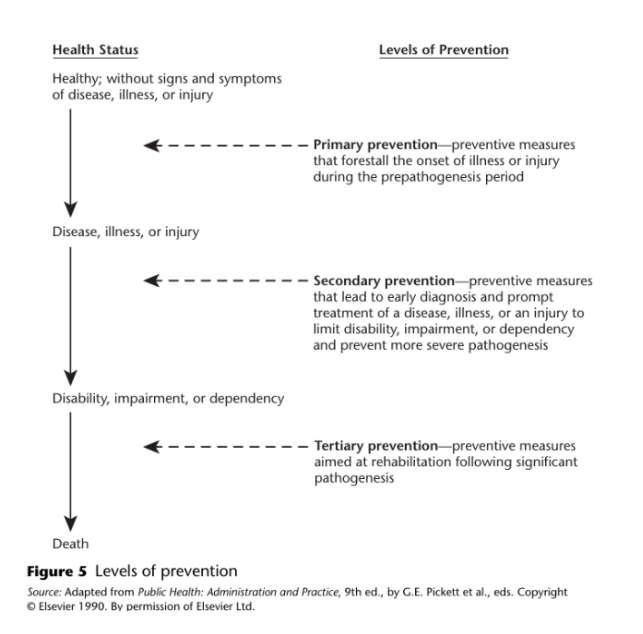
Limits/Levels of Prevention
Note that prevention has its limits!
Biological (lifespan)
Technological (ex technology for AIDS is still unknown)
Ethical ( we can only do so much without limiting peoples right to autonomy)
Economic (there’s only so much money)
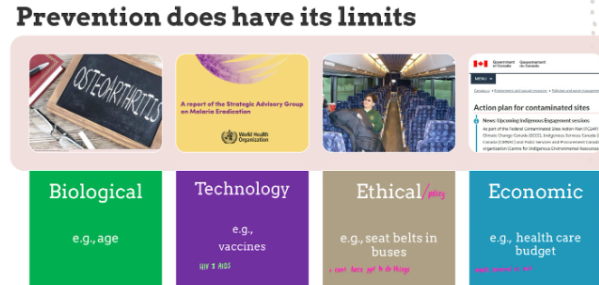
Risk factors
TEXTBOOK
Those inherited, environmental, and behavioral influences “which are known (or thought) to increase the likelihood of physical or mental problems”
Risk factors increase the probability of morbidity and premature mortality but do not guarantee that people with a risk factor will suffer the consequences.
SLIDES
“any attribute, characteristic or exposure of an individual that increases the likelihood of developing a disease or injury”
Control of modifiable risk factors could prevent 40% of all premature deaths.
TWO CATEGORIES
Modifiable: change or controllable
Non modifiable: non-changeable or uncontrollable
Communicable vs non-communicable diseases
TEXTBOOK Communicable diseases are those diseases for which biological agents or their products are the cause and that are transmissible from one individual to another noncommunicable diseases or illnesses are those that cannot be transmitted from an infected person to a susceptible, healthy one SLIDES Communicable diseases are illnesses cause by specific biological agents that can be transmitted from an infected person, animal, or inanimate reservoir to a susceptible host Non communicable diseases are illnesses that cannot be transmitted from an infected host to a susceptible host |
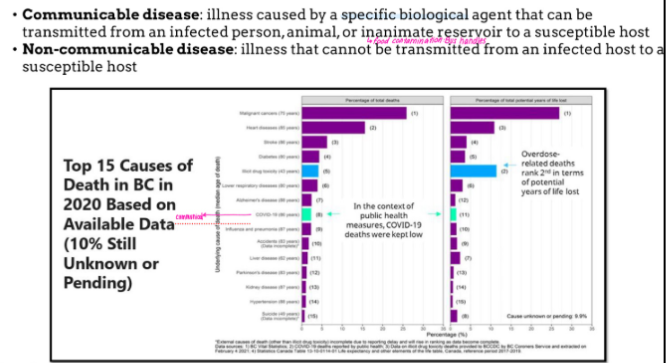
Chain of infection
model used to explain the spread of a communicable disease from one host to another. The basic premise rep resented in the chain of infection is that individuals can break the chain (reduce the risk) at any point; thus, the spread of disease can be stopped.
Main components
Pathogen or infectious agent (bacteria, fungi, viruses, parasites) You can stop the chain of infection here by chlorinating water supply, or pasterization of milk
Human reservoir or reservoir (dirty surfaces, people, animals) You can stop the chain of infection here by isolation, drug treatment, quarantine.
Portal of exit (open wounds or skin, splatter of bodily fluids, aerosols) You can stop the chian of infection here by having gowns, masking, condoms, hair nets, insect repellents.
Mode of transmission or transmission (direct or indirect contact, ingestion, inhalation) You can stop the chain of infection here by isolation, hand washing, santiary engineering, sneeze glass, sexual abstinence.
Portal of entry (broken skin, respiratory tract, mucous membranes, catheters and tubes) You can stop the chain of infection here by having a mask, band-aids, and safety glasses.
Establishment of diseases in a new host or susceptible host (any person especially those receiving healthcare) You can stop the chian of infection here by immunizations, heakth education, nutrition promotion
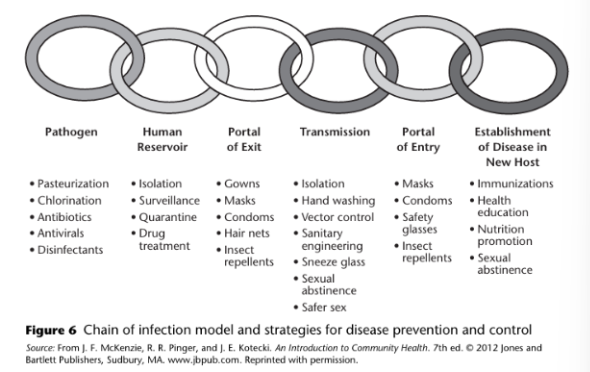
Health Education/Promotion
Health education and promotion work on the idea that people make healthier choices when they get clear, consistent, and well-planned learning experiences. This belief comes from research showing that programs in schools, workplaces, hospitals, and media can help people improve their health.
PRACTICE
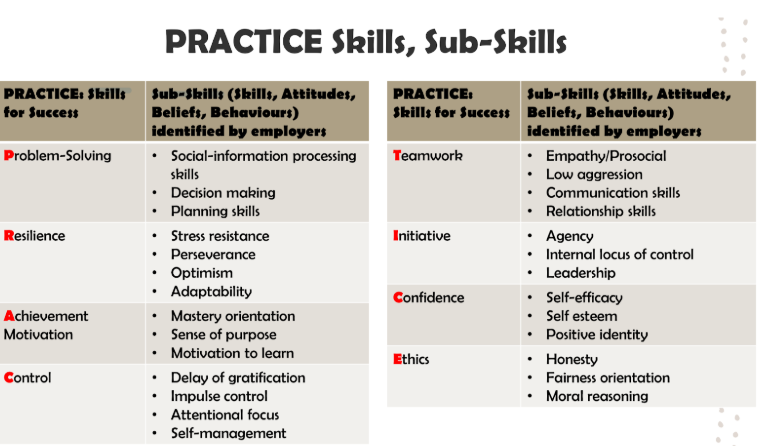
ART
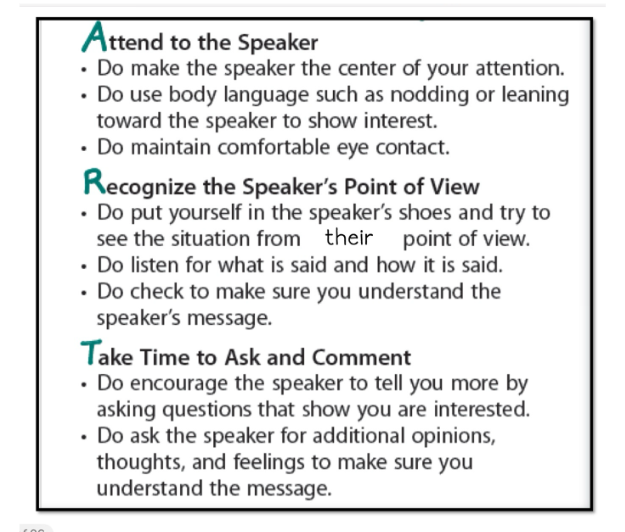
Attributes of Health Educators
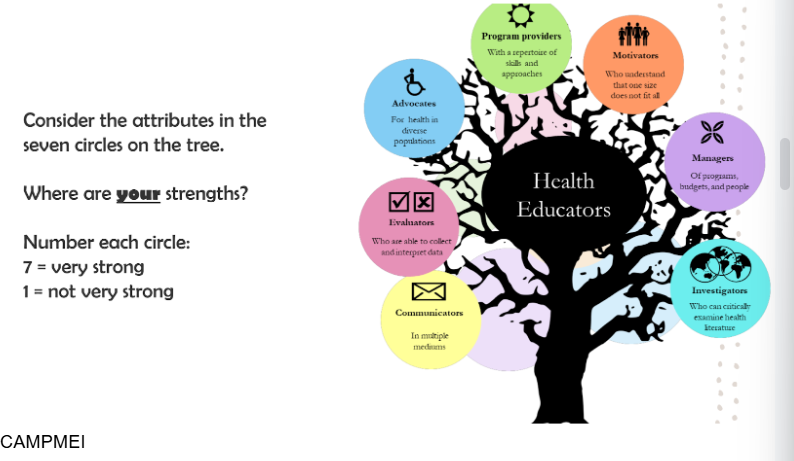
Identify the dual roots of modern health education and promotion
Healthy living and healthy behaviour
Modern health education and promotion are rooted in religion. The focus of health education eventually changed from merely teaching physiology and hygiene (which was factual but unrelated to daily living) to emphasizing healthy living and health behavior
which two fields or movements laid the foundation for the way we teach and promote health today. The answer usually points to school health programs and public health initiatives—each contributing different strategies and goals that eventually merged into the modern approach.
Tension between preventative (stopping disease before it starts) and curative medicine (treating after illness occurs).
Newsholme had an analysis of why this happens
INCOMPLETE KNOWLEDGE: The scientific understanding of how to prevent many diseases was limited or partial. Meaning treatment was more reliable than prevention.
BARRIERS TO APPLYING PREVENTIVE KNOWLEDGE: People were unaware, unwilling or unable to apply preventative knowledge. Gap between knowledge and behaviour made prevention less effective in practice, reinforcing the need for treatment.
URGENCY TO TREAT EXISITNG ILLNESS: ethical responsibility to treat those who were already sick. Linked to the ambulance theory; while prevention is ideal, you must first respond to the accident before you can investigate and prevent future ones.
This all shows how before 1950, there wasn't a great emphasis on professional health education specialists. Just public health efforts.
Health Education and promotion in ancient cultures and middle ages
Ancient Cultures
Egyptians - cleanest
Hebrew - hygenic code in leviticus.
Greeks - Emphasis on disease prevention (aslcepius, hippocrates)
Romans - engineering health
Middles ages faith over science
Middle Ages (Dark Ages)
Context is Roman Empire falls, health advancements lost, no Roman Empire to protect people so everyone started to lived in walled cities.
New Christian influence: preist prevent and treat diseases, knowledge of human body is shunned.
Events from the middle ages such as epidemics of leprosy and bubonic plague helped gain acceptance of the idea that disease can go from person to person
Overall, the ancient cultures were much more advanced in their thinking because faith was paired with the observations and trial and error of the time, whereas middle ages disregarded all the thoughts that came from this time.
Health education and promotion in both of these came from priest and religion. How they were interpreted and put inot practice changed from one another.
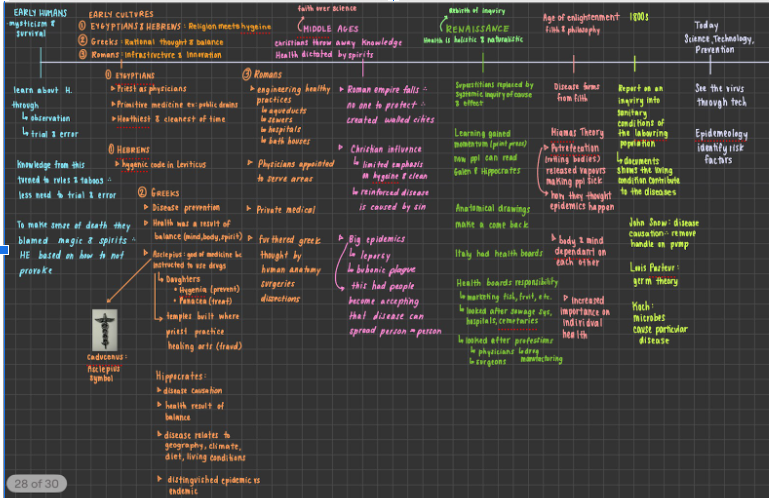
Growing up Canadian first 15 mins